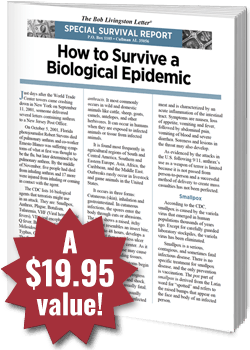A Special Message from Bob Livingston
Are You Prepared for Another Global Epidemic… Catastrophic Terrorist Attack… Wildfire… Power Grid Failure… Scarce Food and Water…
Are you prepared if the unthinkable happens?
Dear Concerned Friend,
You live in a world where terrorist attacks… natural disasters… wildfires… global epidemics… and social unrest are paraded across our news channels on a daily basis. The recent attack in New Orleans and the California wildfires are examples.
Sadly, these risks are rising — quickly!

Former House Speaker Kevin McCarthy warned shortly after the recent Israeli attacks began, “We should wake up ourselves… we could have the same thing happen next week to us. Your intel is never perfect, and we’ve got a wide-open border.”
Former FBI Agent Eric Coron, now a security and counter-terrorism consultant, says, “The idea that they [Middle Eastern terrorists] don’t want to attack us again like a 9/11, but even bigger, is foolish. They want to attack us. They want to destroy America.”
“The idea that they [Middle Eastern terrorists] don’t want to attack us again like a 9/11, but even bigger, is foolish. They want to attack us. They want to destroy America. ”
— Former FBI Agent Eric Coron
The only question is when and where the first sleeper cell awakens. Ask yourself…
Are you prepared to protect your family and keep your wealth safe if a disaster, social unrest, or another 9/11 strikes near your home?
Are you prepared to survive without electricity… without water… for weeks, even months?
Experts fear that terrorists could launch an airborne electromagnetic pulse (EMP) attack on America’s power grid — and plunge parts of the U.S. into a nightmare of looting, starvation, and chaos.

Federal agencies are also warning that Iran-linked hackers are targeting U.S. water treatment systems — specifically those that use programmable-logic controllers made by an Israeli firm — since Hamas attacked Israel on October 7.
And like post 9/11, terrorists may once again spread anthrax or other biological agents via the mail or other means throughout the U.S. Do you know what to do?
Here at The Bob Livingston Letter® we’ve prepared a 2025 Survival Package detailing the most serious threats you could face in 2025 — and specific, real-world strategies you can implement to prepare for them.
In a moment, I’ll explain how to receive this potentially lifesaving information. But first, let’s look at…
SURVIVAL REPORT #1:
Preparing for the Wave of Repercussions as the Middle East Fights “The Last War:” College Protest, Sleeper Cells, and a Repeat of 9/11

This investigative survival report written by myself and my contributing writer, Brandon Smith, reveals why we believe an escalation of attacks on U.S. citizens similar to those on New Year’s Eve in New Orleans and Las Vegas are highly likely — here on U.S. soil and abroad.
Hamas’ brutal killing of Israeli civilians and the use of Palestinian hospitals for cover for these thugs should remind every American to be prepared for such attacks within the U.S. — even the possibility of another 9/11.
In this report you’ll discover:
- How Hamas managed to organize and execute the invasion without Israeli intel services knowing about it. Mossad is known to be one of the most intrusive and pervasive covert agencies in the world, yet they were caught completely off guard by this massive attack. But were they?
- Reasons the U.S. will be drawn into another Middle Eastern war.
- Why oil prices could skyrocket overnight.
- The “real” reason that the Biden administration encouraged open borders. Hint: It has historic precedence!
- U.S. intelligence failures leading up to 9/11.
- U.S. Customs and Border Protection data on terrorist watch-list border crossings — five times the number of terrorists involved in 9/11.
- Justice Department information on active Sleeper Cells operating throughout the U.S. — Black Ops units of Hezbollah.
- Eight U.S. tax-exempt groups who currently support and fund terrorism — including antisemitism on college campuses.
SURVIVAL REPORT #2:
How to Survive a Catastrophic Terrorist Attack or Social Unrest

When terrorists flew airplanes into the World Trade Center Towers and the Pentagon on September 11, 2001, Americans came to realize they were no longer safe from terrorists and the fear and destruction they can inflict.
Since then, there have been terrorist attacks against Americans within the U.S. borders and throughout the world.
Evil takes on many forms. In How to Survive a Catastrophic Terrorist Attack or Social Unrest you’ll learn the four methods Islamic terrorists are most likely to use on U.S. soil, how to prepare for them and much, much more:
- Three destructive devices that rogue nations are smuggling across our southern borders.
- Seven things you’ll need to prepare a safe room in case of a chemical, biological, or radiological disaster.
- An easy, inexpensive way to protect portable radios and laptops from electromagnetic pulses — allowing you to stay in touch with the outside world if local communications fail.
- The importance of a “take box” — everything you need to reconstruct your life in the event you evacuate your home and everything is lost.
- The top 20 emergency supplies you need to survive any disaster.
- How you can prepare for social disruptions while living in a city or suburbs.
- When it’s unsafe or unwise to use the highway system, do you know how to find the best escape route?
- Proven strategies for escaping a flash mob or riot.
- And more…
SURVIVAL REPORT #3:
How to Survive a Biological Epidemic

Just days after the World Trade Center Towers came crashing down, someone delivered several letters containing anthrax to a New Jersey post office. This wasn’t the only case.
By mid-November 2001, five people had died from inhaling anthrax and 117 more were injured from inhaling or coming in contact with the agent.
The Centers for Disease Control (CDC) lists 16 biological agents that terrorists might use in an attack. In this recently updated report, you’ll learn about each of these agents and much more:
- The six most dangerous biological agents that terrorists are most likely to use.
- Steps you can take before a biological attack happens.
- Caught outside during a chemical disaster or biological attack? Four things to consider as you evacuate the area.
- How to avoid becoming a victim of a new “superbug.”
- Five steps you must take when you hear about a biological attack in the U.S.
- If you believe you’ve been exposed to a biological agent, steps you should immediately take.
- How to quickly, and successfully, decontaminate your body of infectious biological agents — before they infect you with disease.
- What you need to know about gas masks — and why they could make you more likely to become infected from a biological agent.
- Seven things you must do to avoid MRSA or other drug-resistant bacteria.
- Whether to flee or bunker down at home.
- What you need to know to survive without electricity.
- Eight items you’ll need for a long-term versus short-term crisis.
- And lots MORE!
Get Started Today and We’ll Take ALL the Risk!
As a valued Bob Livingston Letter® subscriber, you can receive the 2025 Survival Package — a $59.85 value for just $39.95! You’ll receive:

- SURVIVAL REPORT #1: Preparing for the Wave of Repercussions as the Middle East Fights “The Last War:” College Protest, Sleeper Cells, and a Repeat of 9/11 — a $19.95 value!
- SURVIVAL REPORT #2: How to Survive a Catastrophic Terrorist Attack or Social Unrest — a $19.95 value!
- SURVIVAL REPORT #3: How to Survive a Biological Epidemic — a $19.95 value!
That’s a total savings of $19.90!
For just $39.95 — less than 1/65th of a single ounce of gold — you’ll have in your hand the critical information that will prepare you and your family for the next global epidemic, wildfire, catastrophic terrorist attacks, power grid failure, and so much more.
All you have to do is Click Below and we’ll rush your 2025 Survival Package with all three Survivor Reports.
But here’s the best part. If you decide you are not completely satisfied with the information in the 2025 Survival Package, we’ll return every penny you paid.
To your health, wealth, and safety!

Bob Livingston
P.S. I’ve never felt more urgency about preparing for the unthinkable, whether it’s a natural disaster, another global epidemic, social unrest in your neighborhood, or another 9/11 terrorist attack. Please order my 2025 Survival Package today for just $39.95 — a savings of $19.90!
NO-RISK SURVIVAL CERTIFICATE
• $19.90 In Savings! • Grab Them ALL Now — While Supplies Last! • 100% Full-Refund Guarantee!
 YES! I want to prepare for the unthinkable… natural disaster, global epidemic, social unrest, or a terrorist attack on U.S. soil. Please send me the
2025 Survival Package for just 39.95. I understand that I will receive the following three reports:
YES! I want to prepare for the unthinkable… natural disaster, global epidemic, social unrest, or a terrorist attack on U.S. soil. Please send me the
2025 Survival Package for just 39.95. I understand that I will receive the following three reports:
- Survival Report #1: Preparing for the Wave of Repercussions as the Middle East Fights “The Last War:” College Protest, Sleeper Cells, and a Repeat of 9/11 — a $19.95 value!
- Survival Report #2: How to Survive a Catastrophic Terrorist Attack or Social Unrest — a $19.95 value!
- Survival Report #3: How to Survive a Biological Epidemic — a $19.95 value!

That’s a total savings value of $19.90!

